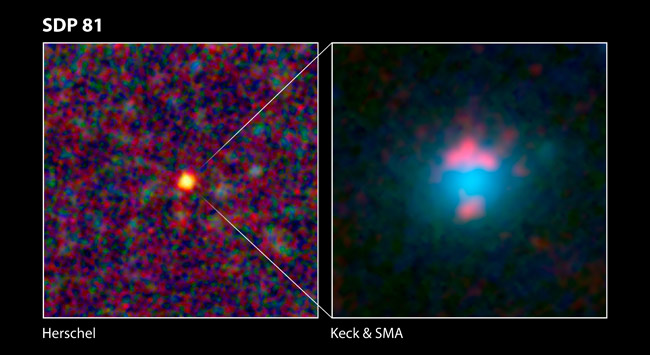Using Space-Time Distortions, Scientists Discover Hidden Galaxies

Previouslyhidden behind veils of dust, ancient galaxies have been detected usinganeffect caused by the space-time distortions in the vast distancebetween thosegalaxies and Earth.
Thediscovery of the distant galaxies could shed light on formation of theearlyuniverse and galaxies, researchers said. [Newphoto of theancient galaxies]
Distantgalaxies are normally difficult to see, but those whose dim light areshroudedin dust are especially difficult to detect, even using the largestavailabletelescopes. However, astronomers are able to essentially boost theeffectiveness of their telescopes by relyingon lenses of a sort ? massive galaxies or clusters ofgalaxies between theastronomers and the objects they want to look at.
Thegravitational pull of massive intervening objects distorts space-time,aneffect that can deflect light. This "gravitationallensing"can increase the visibility of the distant galaxies ? or possibly leadresearchers to seeing multiple images of them.
Typically,finding gravitational lenses is very time-consuming. Now, using datafrom theHerschelSpace Telescope, a large, international research team hasfound thatgravitationally lensed galaxies can be detected easily in submillimeterwavelengths of light if a sufficiently wide area of the sky is searched.
Theobjects seen in the submillimeter range are generally thought to bedistant,dusty galaxies undergoing a vigorous burst of star formation. Thisintenseactivity generates the dust that obscures them. In a wedge of sky thatresearchers analyzed, they discovered what appears to be five newgravitationally lensed, dusty star-forming galaxies.
"Iwas predicting about four to six of these sources to be detected in ourfirstdata collected one year ago," said researcher Mattia Negrello, anastronomer and cosmologist at The Open University in Milton Keynes,England."Those data corresponded to about 3 percent of the total area that willbemapped by Herschel within the H-ATLAS (Herschel Astrophysical TerahertzLargeArea Survey). You can imagine how excited I was when we discoveredexactlyfive."
Get the Space.com Newsletter
Breaking space news, the latest updates on rocket launches, skywatching events and more!
Themethod the researchers used was simpler than past techniques.
Theyobserved the sky for submillimeter radiation, identified the brightestobjectsand removed a few "contaminants" such as nearby galaxies. Everythingthatwas left turned out to be the star-forming galaxies. "This isarguablythe easiest way to spot gravitational lensing events ever conceived,"Negrello said.
Thefive galaxies the researchers found are just the tip of the iceberg,Negrellotold SPACE.com. "We expect to discover more than 100 of them in thefullH-ATLAS," he said. By capturing details amplified by gravitationallensingon largenumbers of these galaxies, the scientists hope to betterunderstand howthey formed and evolved.
Thescientists detailed their findings in the Nov. 5 issue of the journalScience.
- Gallery:Photos Catch Thousands of Galaxies Together at Once
- Video:Black Holes: Warping Time & Space
- DarkEnergy Mystery Illuminated By Cosmic Lens
Join our Space Forums to keep talking space on the latest missions, night sky and more! And if you have a news tip, correction or comment, let us know at: community@space.com.

Charles Q. Choi is a contributing writer for Space.com and Live Science. He covers all things human origins and astronomy as well as physics, animals and general science topics. Charles has a Master of Arts degree from the University of Missouri-Columbia, School of Journalism and a Bachelor of Arts degree from the University of South Florida. Charles has visited every continent on Earth, drinking rancid yak butter tea in Lhasa, snorkeling with sea lions in the Galapagos and even climbing an iceberg in Antarctica. Visit him at http://www.sciwriter.us









